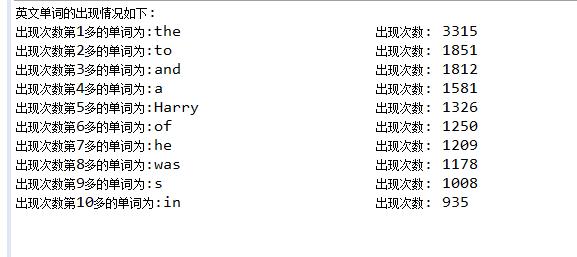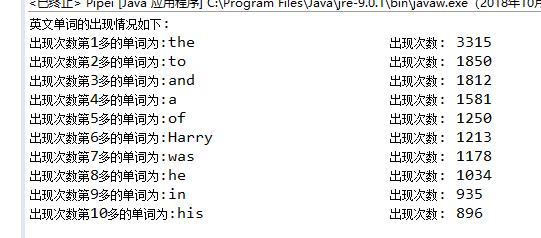JAVA实验--统计文章中单词的个数并排序
Posted Halone
tags:
篇首语:本文由小常识网(cha138.com)小编为大家整理,主要介绍了JAVA实验--统计文章中单词的个数并排序相关的知识,希望对你有一定的参考价值。
分析:
1)要统计单词的个数,就自己的对文章中单词出现的判断的理解来说是:当出现一个非字母的字符的时候,对前面的一部分字符串归结为单词
2)对于最后要判断字母出现的个数这个问题,我认为应该是要用到map比较合适吧,因为map中有 键-值 的关系,可以把字符串设置为键,把出现的个数设置为整型,这样就能够建立起一一对应的关系,不用再判断所在的位置
根据上面自己的理解,今天我写了以下的一部分代码,对哈利波特第一集的这部分文章进行了单词的统计的测试,测试的结果相对良好,没有问题。
package pipei; //洪鼎淇 20173627 信1705-3 import java.io.File; import java.io.FileInputStream; import java.io.FileOutputStream; import java.io.IOException; import java.io.InputStreamReader; import java.io.OutputStreamWriter; import java.util.HashMap; import java.util.Map; //哈利波特单词统计 public class Pipei { public Map<String,Integer> map1=new HashMap<String,Integer>(); public static void main(String arg[]) { String sz[]; Integer num[]; final int MAXNUM=10; //统计的单词出现最多的前n个的个数 sz=new String[MAXNUM+1]; num=new Integer[MAXNUM+1]; Pipei pipei=new Pipei(); int account =1; //Vector<String> ve1=new Vector<String>(); try { pipei.daoru(); } catch (IOException e) { // TODO 自动生成的 catch 块 e.printStackTrace(); } System.out.println("英文单词的出现情况如下:"); int g_run=0; for(g_run=0;g_run<MAXNUM+1;g_run++) { account=1; for(Map.Entry<String,Integer> it : pipei.map1.entrySet()) { if(account==1) { sz[g_run]=it.getKey(); num[g_run]=it.getValue(); account=2; } if(account==0) { account=1; continue; } if(num[g_run]<it.getValue()) { sz[g_run]=it.getKey(); num[g_run]=it.getValue(); } //System.out.println("英文单词: "+it.getKey()+" 该英文单词出现次数: "+it.getValue()); } pipei.map1.remove(sz[g_run]); } int g_count=1; String tx1=new String(); for(int i=0;i<g_run;i++) { if(sz[i]==null) continue; if(sz[i].equals("")) continue; tx1+="出现次数第"+(g_count)+"多的单词为:"+sz[i]+"\\t\\t\\t出现次数: "+num[i]+"\\r\\n"; System.out.println("出现次数第"+(g_count)+"多的单词为:"+sz[i]+"\\t\\t\\t出现次数: "+num[i]); g_count++; } try { pipei.daochu(tx1); } catch (IOException e) { // TODO 自动生成的 catch 块 e.printStackTrace(); } } public void daoru() throws IOException { File a=new File("1.Harry Potter and the Sorcerer\'s Stone.txt"); FileInputStream b = new FileInputStream(a); InputStreamReader c=new InputStreamReader(b,"UTF-8"); String string2=new String(); while(c.ready()) { char string1=(char) c.read(); if(!isWord(string1)) { if(map1.containsKey(string2)) { Integer num1=map1.get(string2)+1; map1.put(string2,num1); } else { Integer num1=1; map1.put(string2,num1); } string2=""; } else { string2+=string1; } } if(!string2.isEmpty()) { if(map1.containsKey(string2)) { Integer num1=map1.get(string2)+1; map1.put(string2,num1); } else { Integer num1=1; map1.put(string2,num1); } string2=""; } c.close(); b.close(); } public void daochu(String txt) throws IOException { File fi=new File("tongji.txt"); FileOutputStream fop=new FileOutputStream(fi); OutputStreamWriter ops=new OutputStreamWriter(fop,"UTF-8"); ops.append(txt); ops.close(); fop.close(); } public boolean isWord(char a) { if(a<=\'z\'&&a>=\'a\'||a<=\'Z\'&&a>=\'A\') return true; return false; } }
测试截图:

这是出现的单词的截图情况,对于其中出现s的情况的分析,s其实是单词里面的缩写,一般往往有It\'s 这种情况的出现,为了避免这种情况,我对文中的某一部分进行修改(修改部分如下图),将It\'s看成一部分

isWord函数判断是否为字母的这一部分将单引号也作为一个符号放进去

修改完之后的测试如下:

搞定!!
以上是关于JAVA实验--统计文章中单词的个数并排序的主要内容,如果未能解决你的问题,请参考以下文章